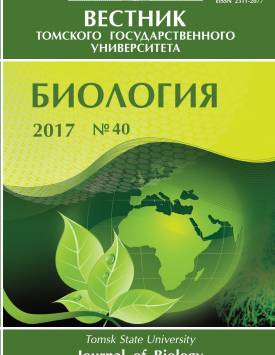Effect of high-siliceous rocks (diatomite, zeolite and bentonite clay) on the activity of the oligothrophic and autochthonous microbial pool in sod-podsolic soil
At present, a relevant issue in soil science is analysis of soil-biotic complex condition in connection with using natural siliceous materials as fertilizers and ameliorants. In this regard, the aim of this research was to study soil microbial status using the example of microorganisms of oligothrophic and autochthonous ecological niches, as the main representatives of K- and R-life support strategies, which are responsible for transformation of soil organic matter, including humus. In microfield experiments (2015-2016), launched in sod-podsolic soil of Nizhny Novgorod Region, we investigated the effect of various doses of three natural siliceous materials - diatomite of the Inzensky field (Ulyanovsk region), zeolite of the Hotynetsky field (Oryol region), and bentonite clay of the Zyrian field (Kurgan region) on oxidoreductase enzymatic activity of the soil, and on the number of oligothrophic and autochthonous microorganisms in it, as well as humus content (See Table 1 for chemical composition of natural siliceous materials used in the experiment). In lab experiments, we carried out dynamic tests on potential biochemical degradation of rock matter by the accumulative cultures of bacterial complexes, isolated from the soil. We launched field experiments according to standard rules of carrying out microplot field studies (registration area of a plot - 1 m2, arrangement of plots - randomized, replication - quadruple). The number of bacterial cells was determined by Koch's method using nitrite agar Tepper and "starvation" agar. Enzymatic activity was determined by pyrocatechol titrimetric methods; identification of genus (species) diversity of bacteria -according to cultural, physiological and biochemical characteristics, including by light and luminescent microscopy with acridine orange; content of specific organic matter (humus) in soil - by its oxidation with sulfur-chromium mixture and spectrophotometeric measuring. Under conditions of a two-year field experiment (See Table 2), we observed an insignificant decrease in the number of oligothrophic bacteria in soil (from the maximum dose of all rocks, on average, up to 6%), and also an essential decrease in the quantity of autochthonous microorganisms (up to 16-19% in variants with the greatest dose of zeolite and diatomite, respectively; up to 27% in the similar variant with bentonite clay). Polyphenoloxidase activity of soil (See Table 3) increased up to 9% in case of zeolite use, up to 13% - in case of diatomite use, and up to 18% of the maximum dose of bentonite. Peroxidase activity of soil tended to be slightly inhibited. In laboratory experiments on potential bacterial degradation of rock matter (See Figure 1), we revealed similar regularities- the number of autochthonous bacteria steadily decreased by the end of the experiment (to 0.11х105 live cells/ml), but the number of viable cells of oligothrophic microorganisms was stabilized with reference values (on average, to 0.22, 0.17 and 0.66х105 of live cells/ml in three rocks). We established a positive effect of the matter of siliceous materials on the accumulative culture polyphenoloxidase activity of autochthonous microorganisms (See Figure 2), as well as redistribution of genus (species) occurrence of their identified cells (See Table 4). Here, we observed a reduction in the number of Nocardia Rubra (from 30% to 5%) and Nocardia Corallina (from 20% to 5% of the total number of grown cells), as well as an increase in Nocardia Symbiotica occurrence (up to 20% in the variant with zeolite, up to 30% in the variant with diatomite and more, than 30% in the variant with bentonite clay). Similar regularities are also revealed during two years of field tests on siliceous materials. On the basis of all obtained data and positive dynamics of humus biochemical transformation coefficient (See Table 5) and its content in soil (See Table 6) it can be asserted that the interaction of the studied rocks with sod-podsolic soil promotes stabilization of its microbial pool of K- and the R-life support strategies and its enzymatic activity during transformation of humic compounds, which, in its turn, increases the retention of specific organic matter in the fertile layer. The revealed interrelations allow us to regard diatomite, zeolite and bentonite clay as stabilizers of the microbial status of the soil-biotic complex concerning the processes of humic substances transformation in soil. The article contains 2 Figures, 6 Tables and 37References.
Keywords
stabilization of humus transformation microbiology, natural siliceous materials, specific organic matter, polyphenoloxidase and peroxidase activity, стабилизация микробиологии трансформации гумуса, природные кремнийсодержащие материалы, специфическое органическое вещество, полифенолоксидазная и пероксидазная активностьAuthors
| Name | Organization | |
| Kozlov Andrey V. | Minin Nizhny Novgorod State Pedagogical University | a_v_kozlov@mail.ru |
| Kulikova Alevtina H. | Stolypin Ulyanovsk State Agricultural University | agroec@yandex.ru |
| Uromova Irina P. | Minin Nizhny Novgorod State Pedagogical University | uromova2012@yandex.ru |
References

Effect of high-siliceous rocks (diatomite, zeolite and bentonite clay) on the activity of the oligothrophic and autochthonous microbial pool in sod-podsolic soil | Vestnik Tomskogo gosudarstvennogo universiteta. Biologiya - Tomsk State University Journal of Biology. 2017. № 40. DOI: 10.17223/19988591/40/3
